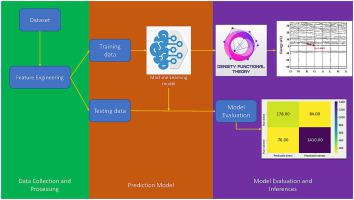Journal of Materiomics ( IF 8.4 ) Pub Date : 2022-04-27 , DOI: 10.1016/j.jmat.2022.04.006 Sudha Priyanga G 1 , Manoj N. Mattur 2 , N. Nagappan 3 , Smarak Rath 3 , Tiju Thomas 3

|
A material's electronic properties and technological utility depend on its band gap value and the nature of band gap (i.e. direct or indirect). This nature of band gaps is notoriously difficult to compute from first principles. In fact it is computationally intense to approximate and also rather time consuming. Hence its prediction represents a challenging problem. Machine learning based approach offers a promising and computationally efficient means to address this problem. Here we predict the nature of band gap for perovskite oxides (ABO3) with elemental composition, ionic radius, ionic character and electronegativity. We do this by training machine learning models on computationally generated datasets. Knowing the nature of the band gap of the perovskite oxides (whether direct or indirect) plays a pivotal role in determining whether the perovskite can be used for photovoltaic or photocatalytic applications. A total of 5329 perovskite oxides are considered in this study. Here, we determine the correlation between the nature of band gap and the composition of the perovskite oxide. A Random Forest algorithm is used for predicting the same since it yielded higher accuracy (∼91%) compared to the other Machine Learning models. The approach suggested here can be used to predict the nature of bandgap and can also aid in novel materials discovery within the family of perovskites. This is a robust, quick, and low-cost strategy to find novel materials for light harvesting applications in particular. Also we present feature ranking as it pertains to prediction of nature of bandgap and also discuss correlation between the features. We also show feature importance graphs and SHapley Additive exPlanations (SHAP) as is relevant for prediction of nature of band gaps. Using the approach reported, NaPuO3 and VPbO3 are discovered to be good candidates for solar cell materials (direct band gap∼1.5 eV). Novel composition predictions for targeted applications are the future and our model is a step ahead in this direction.
中文翻译:

使用机器学习方法预测钙钛矿氧化物 (ABO3) 带隙的性质
材料的电子特性和技术效用取决于其带隙值和带隙的性质(即直接或间接)。众所周知,带隙的这种性质很难从第一原理中计算出来。事实上,它的近似计算量很大,而且相当耗时。因此,它的预测代表了一个具有挑战性的问题。基于机器学习的方法为解决这个问题提供了一种有前途且计算效率高的方法。在这里,我们预测了钙钛矿氧化物(ABO 3) 具有元素组成、离子半径、离子特性和电负性。我们通过在计算生成的数据集上训练机器学习模型来做到这一点。了解钙钛矿氧化物(直接或间接)带隙的性质对于确定钙钛矿是否可用于光伏或光催化应用具有关键作用。本研究共考虑了 5329 种钙钛矿氧化物。在这里,我们确定了带隙性质与钙钛矿氧化物组成之间的相关性。随机森林算法用于预测相同的内容,因为与其他机器学习模型相比,它产生了更高的准确度(~91%)。这里建议的方法可用于预测带隙的性质,还可以帮助在钙钛矿家族中发现新材料。这是一种稳健、快速且低成本的策略,可以为特别是光收集应用寻找新材料。我们还提出了特征排名,因为它与带隙性质的预测有关,并且还讨论了特征之间的相关性。我们还展示了与预测带隙性质相关的特征重要性图和 SHapley Additive exPlanations (SHAP)。使用报告的方法,NaPuO发现3和 VPbO 3是太阳能电池材料的良好候选材料(直接带隙~1.5 eV)。针对目标应用的新型成分预测是未来,我们的模型朝着这个方向迈出了一步。











































 京公网安备 11010802027423号
京公网安备 11010802027423号